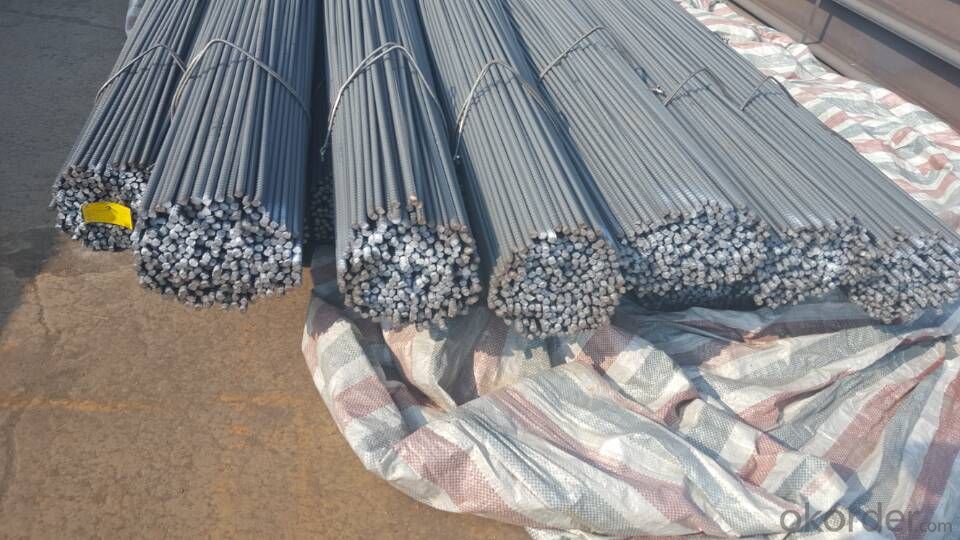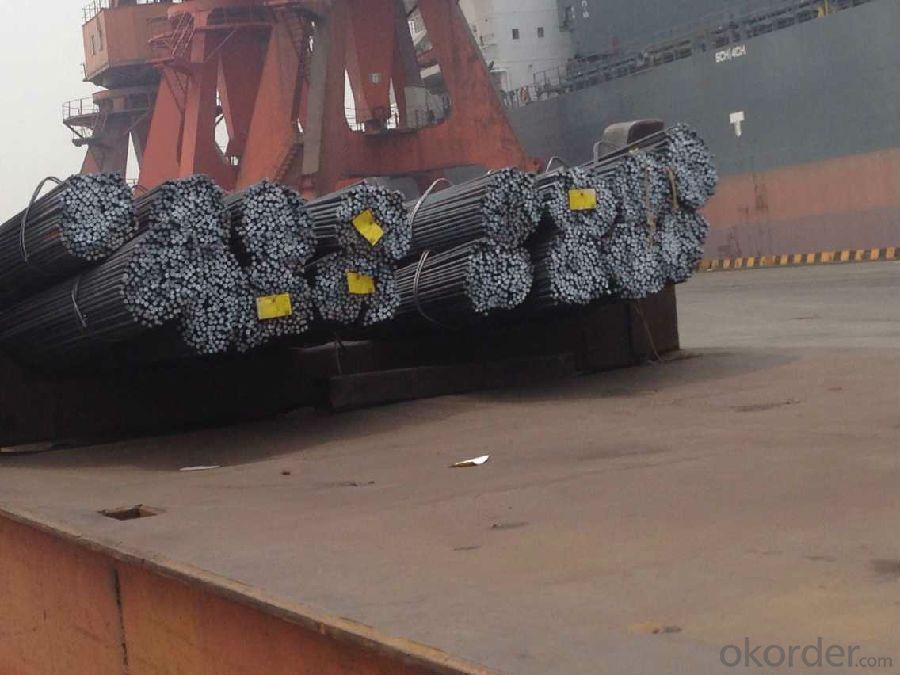Steel Reinforcing Rebars in Hign Quality
- Loading Port:
- China main port
- Payment Terms:
- TT OR LC
- Min Order Qty:
- 100 m.t.
- Supply Capability:
- 10000 m.t./month
OKorder Service Pledge
OKorder Financial Service
You Might Also Like
Product Description:
OKorder is offering Steel Reinforcing Rebars in Hign Quality at great prices with worldwide shipping. Our supplier is a world-class manufacturer of steel, with our products utilized the world over. OKorder annually supplies products to African, South American and Asian markets. We provide quotations within 24 hours of receiving an inquiry and guarantee competitive prices.
Product Applications:
Steel Reinforcing Rebars in Hign Quality are ideal for structural applications and are widely used in the construction of buildings and bridges, and the manufacturing, petrochemical, and transportation industries.
Product Advantages:
OKorder's Steel Reinforcing Rebars in Hign Quality are durable, strong, and wide variety of sizes.
Main Product Features:
· Premium quality
· Prompt delivery & seaworthy packing (30 days after receiving deposit)
· Can be recycled and reused
· Mill test certification
· Professional Service
· Competitive pricing
Product Specifications:
Manufacture: Hot rolled
Grade: HRB335,HRB400,HRB500
Certificates: ISO, SGS, BV, CIQ
Length: 6m – 12m, as per customer request
Packaging: Export packing, nude packing, bundled
Chemical composition (%): | C | Si | Mn | P | S | Ceq | |||
HRB335 HRBF335 |
0.25 |
0.80 |
1.60 |
0.045 |
0.045 | 0.52 | |||
HRB400 HRBF400 | 0.54 | ||||||||
HRB500 HRBF500 | 0.55 | ||||||||
Mechanical properties | Steel | Rel/ MPa | Rm/ MPa | A/ % | Agt/ % | ||||
≥ | |||||||||
HRB335 HRBF335 | 335 | 455 | 17 |
7.5 | |||||
HRB400 HRBF400 | 400 | 540 | 16 | ||||||
HRB500 HRBF500 | 500 | 630 | 15 | ||||||
FAQ:
Q1: what is the difference between actual weight and theoretical weight?
A1: All the section steel has two weights: actual weight and theoretical weight. Actual weight is the weighing out when the product delivered from the mill. Theoretical weight is calculated by pieces. The invoice can be based on each of them as your request.
Q2: How do we guarantee the quality of our products?
A2: We have established an advanced quality management system which conducts strict quality tests at every step, from raw materials to the final product. At the same time, we provide extensive follow-up service assurances as required.
Q3: How soon can we receive the product after purchase?
A3: Within three days of placing an order, we will arrange production. The normal sizes with the normal grade can be produced within one month. The specific shipping date is dependent upon international and government factors, the delivery to international main port about 45-60days.
Images:


- Q:Are steel rebars suitable for use in extreme weather conditions?
- Yes, steel rebars are suitable for use in extreme weather conditions. Steel has excellent structural strength and durability, making it resistant to harsh environmental factors such as high winds, heavy rainfall, extreme temperatures, and even seismic activity. Additionally, steel rebars can be coated or treated to provide further protection against corrosion in areas with high humidity or exposure to saltwater. Overall, steel rebars are a reliable choice for ensuring the structural integrity of buildings and infrastructure in extreme weather conditions.
- Q:How do steel rebars affect the overall construction cost of industrial buildings?
- Steel rebars can have a significant impact on the overall construction cost of industrial buildings. Rebars are used as reinforcement in concrete structures, providing strength and durability. The amount of steel rebars required in a building project directly affects the cost, as the price of steel is a major component of the overall construction expenses. Firstly, the quantity of rebars needed depends on the size, design, and complexity of the industrial building. Larger buildings or those with intricate architectural features may require a higher number of rebars, resulting in increased costs. Additionally, the design and engineering requirements for seismic or wind resistance can also influence the quantity of rebars, further impacting the construction budget. Moreover, the quality and grade of the steel rebars used can affect the cost. Higher-grade rebars, such as those with higher tensile strength or corrosion resistance, may be more expensive. However, using higher-grade rebars can provide long-term benefits by enhancing the structural integrity of the building and reducing maintenance and repair costs over its lifespan. Transportation and handling costs also contribute to the overall cost. Steel rebars are heavy and bulky, requiring careful handling and transportation to the construction site. The distance between the steel supplier and the site can significantly impact transportation costs. Additionally, the storage and protection of rebars on-site must be considered to ensure their quality, which may involve additional expenses. Lastly, labor costs associated with the installation of steel rebars should be taken into account. Skilled labor is required to correctly place and tie the rebars according to design specifications and building codes. The complexity of the reinforcement design can affect the time required for installation, ultimately influencing labor costs. In conclusion, steel rebars play a vital role in the construction of industrial buildings by reinforcing concrete structures. The quantity, quality, transportation, and labor costs associated with steel rebars directly impact the overall construction cost. Therefore, careful planning and consideration of these factors are necessary to effectively manage the budget of industrial building projects.
- Q:What is the recommended spacing between steel rebars in concrete?
- The recommended spacing between steel rebars in concrete typically ranges between 3 to 6 inches, depending on the specific project requirements and design considerations.
- Q:What are the guidelines for proper anchoring of steel rebars in concrete structures?
- For the structural integrity and stability of the construction, it is crucial to properly anchor steel rebars in concrete structures. Here are the guidelines for proper anchoring: 1. Embedment length: To ensure sufficient bond strength, the rebars should be embedded in the concrete for a specific length. The required embedment length depends on factors such as rebar diameter, concrete strength, and load conditions, as specified in the design. 2. Lap length: When joining two rebars, a minimum lap length is necessary for reinforcement continuity. The lap length is determined by the rebar diameter, concrete strength, and structural design requirements. 3. Concrete cover: To safeguard the rebars from corrosion and fire, adequate concrete cover should be provided. The concrete cover is the distance between the outer surface of the rebars and the nearest concrete surface. It depends on factors like environmental conditions, fire resistance requirements, and durability considerations. 4. Spacing and arrangement: The rebars should be appropriately spaced and arranged according to the structural design requirements. The spacing is determined by the structural load and design specifications. Inadequate spacing can compromise the structural strength by providing insufficient reinforcement. 5. Proper positioning: Accurate positioning of rebars is essential, following the design drawings and specifications. They should be placed in the concrete formwork before pouring to achieve the desired structural behavior. Incorrect positioning can result in misalignment or insufficient concrete cover. 6. Mechanical anchorage: Mechanical anchorage devices such as rebar couplers, anchor bolts, or hooks can be utilized to enhance rebar anchoring in concrete structures. These devices provide additional reinforcement and prevent slippage or pull-out of the rebars under load. 7. Quality control: Regular inspection and quality control measures should be implemented to ensure compliance with the anchoring guidelines. This includes checking rebar dimensions and spacing, embedment depth, concrete cover, and ensuring proper installation techniques. It is important to note that these guidelines may vary based on project requirements, local building codes, and design specifications. Therefore, consulting a structural engineer or referring to relevant building codes and standards is essential for specific guidelines applicable to each construction project.
- Q:How are steel rebars protected during concrete pouring?
- Steel rebars are protected during concrete pouring by applying a layer of corrosion-resistant coating or by using epoxy-coated rebars. Additionally, rebars are often placed at a specific depth within the concrete to ensure adequate cover and protection against moisture and corrosive elements.
- Q:How can steel rebars be recycled after their service life?
- Steel rebars can be recycled after their service life by first removing them from the concrete structures. The rebars are then collected and taken to a recycling facility where they undergo a process called steel rebar recycling. In this process, the rebars are cleaned, sorted, and shredded into small pieces. These pieces are then melted down in a furnace and transformed into new steel products or rebars, which can be used for various construction purposes. Recycling steel rebars not only conserves natural resources but also helps to reduce waste and minimize environmental impact.
- Q:How are steel rebars used in railway track construction?
- Steel rebars are used in railway track construction to reinforce the concrete sleepers or ties that support the tracks. They provide strength and stability to the tracks, ensuring they can withstand the heavy loads and constant vibrations of trains passing over them. The rebars are embedded within the concrete during the sleeper casting process, enhancing the overall durability and longevity of the railway tracks.
- Q:What is the lifespan of steel rebars in a concrete structure?
- The lifespan of steel rebars in a concrete structure can vary depending on several factors such as the quality of the steel, the environment it is exposed to, and the level of maintenance. However, under normal conditions, steel rebars in a well-designed and properly constructed concrete structure can last for several decades, typically ranging from 50 to 100 years or more. Regular inspections, repairs, and proper protective measures can help extend their lifespan even further.
- Q:Can steel rebars be used in the construction of airports?
- Yes, steel rebars can be used in the construction of airports. Steel rebars are commonly used in reinforced concrete structures, including airport runways, taxiways, and even terminal buildings. Their high tensile strength and durability make them suitable for withstanding heavy loads and ensuring the structural integrity of airport infrastructure.
- Q:Are steel rebars susceptible to corrosion?
- Yes, steel rebars are susceptible to corrosion. Corrosion is a natural process that occurs when steel is exposed to moisture, oxygen, and other environmental factors. When steel rebars are used in concrete structures, they are exposed to the elements and can come in contact with water or moisture, which can lead to the formation of rust. This rust can weaken the rebars and eventually compromise the structural integrity of the concrete. To prevent corrosion, various protective measures can be taken, such as applying a protective coating or using corrosion-resistant steel rebars. Regular maintenance and inspection of the concrete structures are also crucial to detect and address any signs of corrosion in a timely manner.
1. Manufacturer Overview |
|
|---|---|
| Location | |
| Year Established | |
| Annual Output Value | |
| Main Markets | |
| Company Certifications | |
2. Manufacturer Certificates |
|
|---|---|
| a) Certification Name | |
| Range | |
| Reference | |
| Validity Period | |
3. Manufacturer Capability |
|
|---|---|
| a)Trade Capacity | |
| Nearest Port | |
| Export Percentage | |
| No.of Employees in Trade Department | |
| Language Spoken: | |
| b)Factory Information | |
| Factory Size: | |
| No. of Production Lines | |
| Contract Manufacturing | |
| Product Price Range | |
Send your message to us
Steel Reinforcing Rebars in Hign Quality
- Loading Port:
- China main port
- Payment Terms:
- TT OR LC
- Min Order Qty:
- 100 m.t.
- Supply Capability:
- 10000 m.t./month
OKorder Service Pledge
OKorder Financial Service
Similar products
New products
Hot products
Related keywords





























